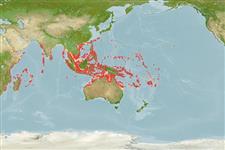Actinopterygii (Straalvinnigen) >
Perciformes (Perch-likes) >
Serranidae (Sea basses: groupers and fairy basslets) > Epinephelinae
Etymology: Epinephelus: Greek, epinephelos = cloudy (Ref. 45335).
Omgeving / Klimaat / Range
Ecologie
; marien rifbewoner; diepteverspreiding 1 - 60 m (Ref. 9710). Tropical, preferred 27°C (Ref. 107945); 29°N - 27°S, 33°E - 167°W (Ref. 5222)
Indo-Pacific: Red Sea and East Africa to Samoa and the Phoenix Islands, north to Japan, south to Australia. Unknown from the Persian Gulf, Hawaii, and French Polynesia. Often confused with Epinephelus polyphekadion (=Epinephelus microdon of recent authors).
Length at first maturity / Size / Gewicht / Leeftijd
Maturity: Lm ?, range 50 - ? cm
Max length : 120 cm TL mannelijk/geslacht niet bekend; (Ref. 2114); common length : 50.0 cm TL mannelijk/geslacht niet bekend; (Ref. 9137); Maximaal gepubliceerd gewicht: 11.0 kg (Ref. 5222); Maximaal vermelde leeftijd: 40 jaren (Ref. 74383)
Dorsale stekels (totaal): 11; Dorsale zachte stralen (totaal): 14-15; Anale stekels 3; Anale zachte stralen: 8. Small juveniles (<8 cm) with small hexagonal spots on head and body becoming larger posteriorly and on vertical fins (Ref. 37816); distinguished by pale yellowish brown color with five vertical series of irregular dark brown blotches; head, body and fins with numerous close-set, small brown spots; caudal peduncle with small black saddle dorsally; cycloid scales except ctenoid in juvenile; body with auxiliary scales; moderately deep bodied, greatest depth 2.6-2.9 in SL; pelvic fins 2.1-2.4 in head length (Ref. 90102); further characterized by having head length 2.3-2.5 times in SL; flat or slightly concave interorbital area; adults dorsal head profile indented at eyes and distinctly convex from there to origin of dorsal fin; rounded preopercle, finely serrate; distinctly convex upper edge of operculum, descending almost vertically to rear end of operculum; deeply indented anterior edge of preorbital bone below nostrils; triangular posterior nostrils, 4-7 times larger than anterior nostrils in adults; maxilla extends well posterior to eye; 3-4 rows of teeth on midlateral part of lower jaw, inner teeth twice as long compared to outer teeth; canines inconspicuous; nostrils are close together (Ref. 89707).
Occurs in lagoon pinnacles, channels, and outer reef slopes, in coral-rich (Ref. 1937) areas and with clear waters. Juveniles in seagrass beds (Ref. 30573, 41878). Feeds on fishes, crabs, and cephalopods. May be ciguatoxic in some areas (Ref. 1602). Mainly active at dusk (Ref. 48635). Palau fishers increase their drop-line and spear-gun catches through knowledge of reproductive cycle of remochel, one of most important species in the area (Ref. 2928). Cultured under experimental conditions in the Philippines; a candidate for aquaculture in Singapore. In Hong Kong live fish markets (Ref. 27253).
Heemstra, P.C. and J.E. Randall, 1993. FAO Species Catalogue. Vol. 16. Groupers of the world (family Serranidae, subfamily Epinephelinae). An annotated and illustrated catalogue of the grouper, rockcod, hind, coral grouper and lyretail species known to date. Rome: FAO. FAO Fish. Synop. 125(16):382 p. (Ref. 5222)
Status op de Rode Lijst van het IUCN (Ref. 115185)
CITES (Ref. 94142)
Not Evaluated
Gevaarlijk voor mensen
Reports of ciguatera poisoning (Ref. 4690)
Gebruik door de mens
Visserij: van minder commercieel belang; Aquacultuur: commercieel; Aquarium: Commercieel
Meer informatie
ReferentiesAquacultuurAquacultuurprofielKweeklijnenGeneticaAlleelfrequentiesErfelijkheidZiektenVerwerkingMass conversion
Tools
Speciale rapporten
Download XML
Internet-bronnen
